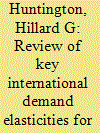|
|
|
Sort Order |
|
|
|
Items / Page
|
|
|
|
|
|
|
| Srl | Item |
| 1 |
ID:
176860


|
|
|
|
|
| Summary/Abstract |
Within Canada, Mexico or the United States, policy-making organizations are evaluating energy markets and energy trade within their own borders often by ignoring how these countries’ energy systems are integrated with each other. These analytical gaps provided the main motivation for the Energy Modeling Forum (EMF) 34 study on North American energy integration and trade. This paper compares North American results from 17 models and discusses their policy motivation. Oil and natural gas production in the three major countries are modestly sensitive to crude oil and natural gas price changes, although these elasticities are below unity. Carbon taxes displace coal and some natural gas with renewables within all three power markets. Lower natural gas prices replace coal and some renewables with natural gas within electric generation. Higher intermittent renewable penetration in the power sector displaces coal and some natural gas. A key conclusion is that much remains to be done in integrating future analyses and in sharing and improving the quality and consistency of the underlying data.
|
|
|
|
|
|
|
|
|
|
|
|
|
|
|
|
| 2 |
ID:
179676


|
|
|
|
|
| Summary/Abstract |
Model evaluation is best considered as a process for communicating with the policymaking or policy-advising community. Six decades of energy modelling have witnessed increasing complexity in these systems, a situation that raises a number of important challenges in using them effectively in policymaking organizations. When used as a learning rather than forecasting tool, these systems can be evaluated individually one by one or through joint efforts to compare them in multi-model exercises. After summarizing the evolution of energy modelling and efforts to evaluate them since the first oil embargo, this essay provides a guide to future evaluation collaborations by highlighting a few challenges that would improve the value of these studies for the policymaking community. These challenges range broadly and cover topics such as enhancing the engagement of the model user, ventilating the models’ complexity with intuitive insights, using simple models to demonstrate key parameters or responses, applying judicious occasional meta-analysis when there is value added, reporting model responses and calibrating them for decisionmakers, considering retrospective evaluation for a past period (when possible), selecting standardized or modeler-choice baseline conditions, selectively developing policy or diagnostic alternative cases, and institutionalising the model evaluation process for a specific topic or region.
|
|
|
|
|
|
|
|
|
|
|
|
|
|
|
|
| 3 |
ID:
168641


|
|
|
|
|
| Summary/Abstract |
This paper conducts a selective review of various estimates for energy demand responses focused specially upon lower-income industrializing economies rather than richer mature nations. It emphasizes recent trends from empirical studies that have been published after 2000. Emphasis is placed on the five major emerging or transitional economies in Brazil, China, India, Mexico and Russia, although other important nations like Chile and South Korea are also discussed when studies are available. The review focuses attention on the long-run responses to changes in prices and income after capital stock turnover has been completed. The terminology often refers to elasticities, or the percentage change in energy use divided by the percentage change in price (or income), holding constant all other factors that could influence energy-use decisions. Estimates cover petroleum products, natural gas and electricity, although the available studies often ignore coal. They also include the economy-wide impacts (real GDP) to price changes. Most studies have focused upon household and transportation use of liquid fuels; many fewer studies have investigated fuels used by industry or commerce or for electric generation. Based upon the available estimates, price and income elasticities for liquid fuels are generally less than one (unity) for many countries and sectors, except for the long-run income effect for transportation purposes, which can range widely by country between 0.24 and 1.75 while averaging 0.94 for all countries.
|
|
|
|
|
|
|
|
|
|
|
|
|
|
|
|
|
|
|
|
|